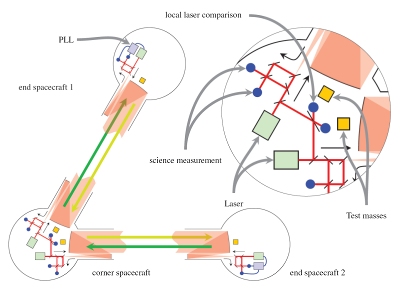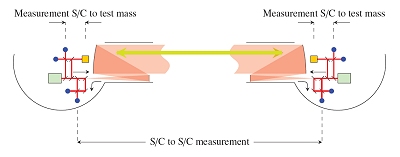Measurement Concept
Instead of merely measuring the propagation and transformation of particles and fields through spacetime, the New Gravitational wave Observatory, NGO, will study the vibrations in the fabric of spacetime itself by directly detecting the effects of gravitational waves.
The mission consists of three spacecraft orbiting the Sun in a configuration that forms a near-equilateral triangle. To measure the strain, or deformation, on the fabric of spacetime caused by gravitational waves, the mission uses interferometric measurements, comparing the phase of two electromagnetic waves, between free-falling test masses over a large baseline defined by the separation between the spacecraft (106 km).
The constellation of the three NGO spacecraft itself forms the science instrument. The two sides of the equilateral triangle, from the apex to the two vertices with a spacecraft at each end, form two measurement arms. Each spacecraft carries the interferometry equipment needed to measure changes in arm length. The spacecraft at the apex, or the 'mother' spacecraft, houses two send/receive laser ranging terminals and two free-falling test masses, forming one set of endpoints of the two measurement arms. The other two spacecraft at the vertices of the triangle, the 'daughter' spacecraft, each housing one laser ranging terminal and free-floating test mass, form the two other endpoints of the measurement arms. The mother and daughter spacecraft are identical, but for the number of payloads they carry.
Interferometric laser ranging
The large distance between the spacecraft makes it necessary to extend the classical concept of an interferometer. Distance measurements are performed using continuous interferometric laser ranging, a technique similar to doppler spacecraft tracking using radar. The direct reflection of laser light, such as in a normal Michelson interferometer, is not feasible due to the large baseline distance between the spacecraft. Diffraction widens the laser beam so that for each watt of laser power sent, about 250 pW are received. Direct reflection would thus result in an attenuation factor of about 6.25 × 10-20, yielding about one photon every three days.
To avoid this, lasers at both ends of each arm operate in 'transponder' mode. A laser beam is sent out from the mother spacecraft to the daughter spacecraft. The laser in the daughter spacecraft is then phase-locked to the incoming beam – it returns a high-power phase replica as the output signal. The returned beam is received by the mother spacecraft and its phase in turn is compared with the phase of the local laser. A similar technique is employed for the second arm. In addition, the phases of the two lasers serving the two arms are compared in the mother spacecraft.
This primary measurement registers changes in the distance with an accuracy of picometres. Apart from this, two additional measurements are needed for data analysis. The first of these is the absolute distance between the test masses.
In contrast to the accuracy of the measurement of change in distance, the measurement of absolute distance is needed only to an accuracy of a few metres. This is done by transmitting a special ranging code on the sidebands of the laser signal.
The other additional measurement concerns the time on each spacecraft. As clocks that can be accommodated on the three spacecraft and have sufficient stability are not available, the relative clock error between the spacecraft is recorded instead. To achieve this, a timing signal is also transmitted on the sidebands of the laser signal.
Combining the phase measurements with these additional measurements makes it possible to determine the changes in the optical path difference, laser frequency noise, as well as clock noise.
For practical purposes, the measurements are split up into three distinct parts: the measurement between the spacecraft (that is, the measurement between the optical benches that are fixed to the spacecraft), and the measurement between each of the test masses and its respective optical bench. By combining these three measurements, the distance between the test masses is reconstructed and kept unaffected by the noise in the position of the spacecraft with respect to the test masses.
Splitting up the measurements in this manner is normally avoided as it increases the noise due to the number of detectors involved. However, as the NGO detector noise is generally negligible, splitting the measurements does not significantly degrade the overall sensitivity.
Sensitivity
NGO will achieve the required strain sensitivity of approximately 3 × 10-20/√√Hz (averaged over all sky locations and polarisations). This allows the spacecraft to detect a strain of about 3.7 × 10-24 in a 2-year measurement, with a signal to noise ratio of 1. After reducing the disturbances on test masses from the data, the sensitivity (of the laser ranging system) to displacement yields a bandwidth of 3 × 10-5 Hz to 1 Hz available for measurements (the mission requirement is 10-4 Hz to 1 Hz; the goal 3 × 10-5 Hz to 1 Hz).
(For more detailed information about the NGO measurement concept, please consult the NGO assessment study report (Yellow Book) - see link in right-hand menu.)




